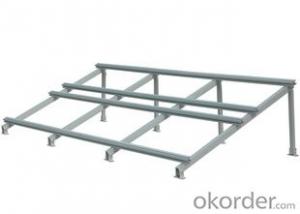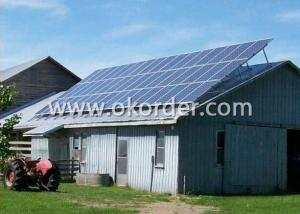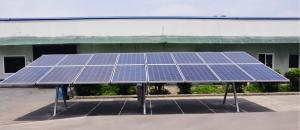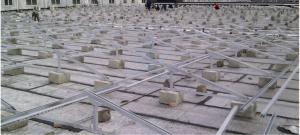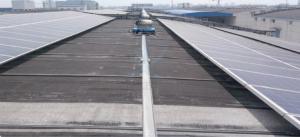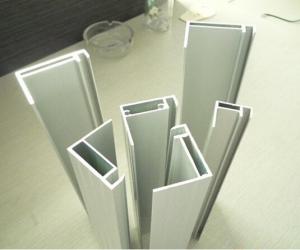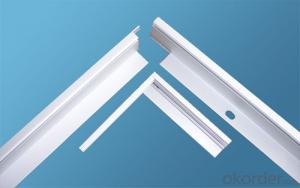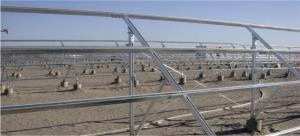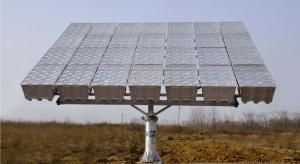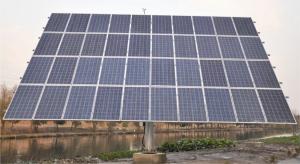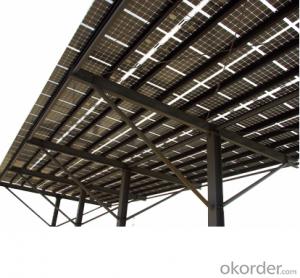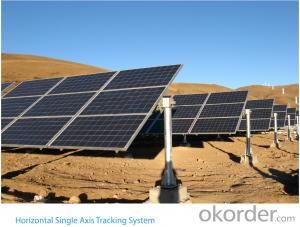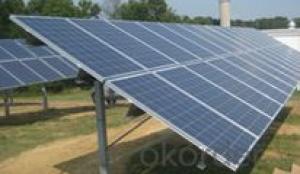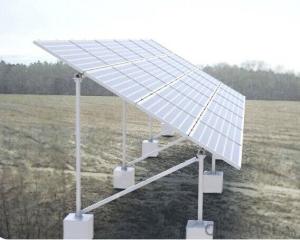solar mounting system
- Loading Port:
- China Main Port
- Payment Terms:
- TT OR LC
- Min Order Qty:
- -
- Supply Capability:
- -
OKorder Service Pledge
Quality Product, Order Online Tracking, Timely Delivery
OKorder Financial Service
Credit Rating, Credit Services, Credit Purchasing
You Might Also Like
technical data of solar mounting system: | |
| installation site: | roof & ground |
| color: | silvery |
| wind load: | up to 60m/s |
| snow load: | up to 1.4KN/m2 |
| PV modules: | frame or frameless |
| module orientation: | portrait or landscape |
| standards: | AS/NZS1170 |
| SGS | |
| materials: | aluminum 6005-T5 |
| steel Q235 | |
| stainless steel | |
| anti-corrosive: | anodized |
| galvanized | |
Specifications
solar mounting system
1,Easy Installation
2,Safety and Reliability
3,Flexibility and Adjustable
4,10 Years QA
advantage of solar mounting system: | |
easy installation: | high pre-assembley in our factory |
| not require onsite weld and cut | |
flexibility & compatible: | can be installed with the most solar panels |
safety & reliability: | have been tested to guarantee its structure and load-carrying capacity. |
customized of solar mounting system: | |
customization: | available |
OEM: | available |
- Q:How does a solar mounting system work?
- A solar mounting system is designed to securely hold solar panels in place and optimize their performance. It typically consists of a structure or framework that is anchored to the ground or a building rooftop. The solar panels are then mounted onto this structure using brackets or clamps. The system is engineered to ensure the panels are tilted at an optimal angle to receive maximum sunlight throughout the day. Additionally, the mounting system provides a safe and stable platform for the panels, protecting them from harsh weather conditions and potential damage.
- Q:Are there any specific requirements for anchoring when using a solar mounting system on a concrete roof?
- Yes, there are specific requirements for anchoring when using a solar mounting system on a concrete roof. The anchoring system should be designed to withstand the weight and wind loads of the solar panels. It is important to ensure that the roof structure is strong enough to support the added weight of the mounting system and panels. Additionally, proper waterproofing and sealing measures should be taken to prevent any potential leakage or damage to the roof.
- Q:Can a solar mounting system be used with solar air heating systems?
- Yes, a solar mounting system can be used with solar air heating systems. A solar mounting system provides the necessary structure and support to install solar panels, which can be used for both photovoltaic (electricity generation) and solar air heating systems. By using a solar mounting system, solar air heating collectors can be securely mounted on rooftops or ground-mounted structures to harness solar energy for heating purposes.
- Q:Can a solar mounting system be installed in areas with high wind speeds?
- Yes, a solar mounting system can be installed in areas with high wind speeds. However, it is important to ensure that the system is designed and installed to withstand the specific wind loads in that area. This may involve using reinforced mounting structures, appropriate anchoring methods, and ensuring proper installation techniques to enhance the system's stability and durability in high wind conditions.
- Q:Can a solar mounting system be integrated into the design of a building?
- Yes, a solar mounting system can be integrated into the design of a building. In fact, many modern buildings are designed with integrated solar panels and mounting systems to maximize energy efficiency and reduce environmental impact. These systems can be seamlessly incorporated into the architectural design, either as rooftop installations, facade-integrated panels, or as part of the building's structure itself. By integrating solar mounting systems into the building design, renewable energy generation can be seamlessly integrated, making it an aesthetically pleasing and sustainable solution.
- Q:Are there any specific requirements for installing solar mounting systems in earthquake-prone areas?
- Yes, there are specific requirements for installing solar mounting systems in earthquake-prone areas. These requirements typically include using advanced seismic analysis and engineering techniques to ensure the mounting structures can withstand the expected level of earthquake activity. Additionally, the use of robust and flexible mounting systems, such as those with adjustable angles and reinforced foundations, is recommended to improve the system's resilience to seismic events. Local building codes and regulations may also provide specific guidelines for installing solar mounting systems in earthquake-prone areas that need to be followed.
- Q:How do you secure a solar mounting system to the ground?
- A common method to secure a solar mounting system to the ground is by using concrete footings or ground screws. Concrete footings involve digging holes and pouring concrete to create a stable foundation. Ground screws, on the other hand, are large metal screws that are twisted into the ground to provide a secure attachment point. Both methods ensure the solar mounting system remains firmly anchored to the ground, even in adverse weather conditions.
- Q:What is the expected efficiency loss over time for a solar mounting system?
- The expected efficiency loss over time for a solar mounting system can vary depending on various factors such as the quality and maintenance of the system, environmental conditions, and technological advancements. However, it is generally expected that solar mounting systems experience a gradual decrease in efficiency over their lifespan due to factors like dust accumulation, aging of materials, and wear and tear. Regular cleaning, maintenance, and upgrades can help minimize this efficiency loss and extend the lifespan of the system.
- Q:Can a solar mounting system be installed on any type of roof?
- Yes, a solar mounting system can generally be installed on any type of roof, including flat roofs, pitched roofs, and even curved or irregular roofs. However, the specific design and installation process may vary depending on the roof type and its structural integrity. It is recommended to consult with a professional solar installer to assess the feasibility and requirements for your specific roof.
- Q:Can a solar mounting system be installed on a mobile or modular structure?
- Yes, a solar mounting system can be installed on a mobile or modular structure. These structures often have limited space for solar panel installation, but with the right design and engineering, solar panels can be securely mounted on the roof or exterior of the structure. This allows for the generation of clean and renewable energy even in mobile or temporary settings.
1. Manufacturer Overview |
|
|---|---|
| Location | |
| Year Established | |
| Annual Output Value | |
| Main Markets | |
| Company Certifications | |
2. Manufacturer Certificates |
|
|---|---|
| a) Certification Name | |
| Range | |
| Reference | |
| Validity Period | |
3. Manufacturer Capability |
|
|---|---|
| a)Trade Capacity | |
| Nearest Port | |
| Export Percentage | |
| No.of Employees in Trade Department | |
| Language Spoken: | |
| b)Factory Information | |
| Factory Size: | |
| No. of Production Lines | |
| Contract Manufacturing | |
| Product Price Range | |
Send your message to us
solar mounting system
- Loading Port:
- China Main Port
- Payment Terms:
- TT OR LC
- Min Order Qty:
- -
- Supply Capability:
- -
OKorder Service Pledge
Quality Product, Order Online Tracking, Timely Delivery
OKorder Financial Service
Credit Rating, Credit Services, Credit Purchasing
Similar products
New products
Hot products
Hot Searches
Related keywords
